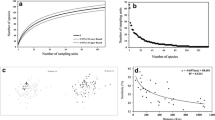Abstract
The geographical distribution of a saprotrophic hyphomycete,Sporidesmium goidanichii was studied in pine forests of Japan. Using the data of 282 fungal communitles of pine leaf litter collected over a wide range of climatic conditions, the relationships among two indexes of distribution of the species (constancy and abundance) and three climatic variables were analyzed by the multiple regression analysis. The results demonstrated that the mean annual air temperature and the mean annual range (the difference in monthly mean air temperatures between the coldest and warmest months at the study sites) were necessary variables for the prediction of the values of indexes ofS. goidanichii in pine forests of Japan, while the mean annual precipitation was an unimportant factor. The distribution patterns of the fungus along the gradients of two temperature variables were analyzed graphically. The fungus has an optimal climatic area with high values of indexes where is restricted to the center of the warm temperate regions of the main islands. The relationship between the life strategy of the fungus and its temperature-dependent distribution pattern in Japan was also discussed.
Similar content being viewed by others
Literature cited
Arnold, E. J. M. 1997. Biogeography and conservation. In: The Mycota Vol. IV. Environmental and Microbial Relationships (ed. by Wicklow D. T. and Söderström, B.), pp. 115–131. Springer-Verlag, Berlin.
Bisby, G. R. 1933. The distribution of fungi as compared with that of phanerogams. Am. J. Sci.20: 246–254.
Castañeda, R. F., Guarro, J., Mayayo, E. and Decock, C. 1988. Notes on conidial fungi. XVL. A new species ofDendrophiosphaera and some new records from Cuba. Mycotaxon67: 9–19.
Dix, N. J. and Webster, J. 1995. Fungal Ecology. Chapman & Hall, London.
Ellis, M. B. 1976. More dematiaceous fungi. C. A. B.,Kew.
Hayashi, Y. 1960. Taxonomical and phytogeographycal study of Japanese conifers. Norin Shuppan, Tokyo (In Japanese.)
Hughes, S. J. 1979. Relocation of species ofEndophragmia acut. with notes on relevant generic names. New Zeeland J. Bot.17: 139–188.
Japan Meteorological Agency 2001. Ordinary values of climatological station.
Kendrick, W. B. and Burgess, A. 1962. Biological aspects of the decay ofPinus sylvestris leaf litter. Nova Hedwigia4: 313–342.
Kirk, P. M. 1982. New or interesting microfungi V. Microfungi colonizingLaurus nobilis leaf litter. Trans. Br. Mycol. Soc.78: 293–303.
Kirk, P. M. and Spooner, B. M. 1984. An account of fungi on Arran, Gigha and Kintyre. Kew Bull.38: 503–597.
Lange, L. 1974. The distribution of macromycetes in Europe. Dansk Bot. Ar.30: 1–105.
Mitchell, C. P., and Millar, C. S. 1978. Mycofloral successions on Corsican pine needles colonized on the tree by three different fungi. Trans. Mycol. Soc.71: 303–317.
Pirozynski, K. A. 1968. Geographical distribution of fungi. In: The Fungi, Vol. 3, (ed. by Ainsworth G. C. and Sussman A. S.). pp. 487–504. Academic Press, New York.
Tokumasu, S. 1980. Observations on the fungal flora in the pine leaf litter. In: Biseibutu-no-seitai (Ecology of Microorganisms), Vol. 7, (ed. by the Society for the Study of Microbial Ecology), pp. 129–144. Gakkai Shuppan Center, Tokyo. (In Japanese).
Tokumasu, S. 1981. Geographical distribution of microfungi inhabiting decaying pine needles. In: Biseibutsu-no-seitai (Ecology of Microorganisms), vol. 9 (ed. by the Society for the Study of Microbial Ecology), pp. 137–149. Gakkai Shuppan Center, Tokyo. (In Japanese).
Tubaki, K. and Saito, T. 1969.Endophragmiella alternata sp. nov., and other Hyphomycetes onPinus leaves in Japan. Trans. Br. Mycol. Soc.52: 477–482.
van Maanen, A. and Gourbiere, F. 1997. Host and geographical distribution ofVerticicladium trifidum, Thysanophora penicillioides, and similar fungi on decaying coniferous needles. Can. J. Bot.75: 699–710.
van Maanen, A., Debouzie, D. and Gourbiere, F. 2000. Distribution of three fungi clonizing fallenPinus sylvestris needles along altitude transects. Mycol. Res.104: 1133–1138.
Wicklow, D. T. 1981. Biogeography and conidial fungi. In: Biology of conidial fungi, Vol. 1, (ed. by Cole, G. T. and Kendrick, B.), pp. 417–447. Academic Press, New York.
Yokoyama, T. and Ito, T. 1977. List of microfungi recorded at mycological forays held at Mt. Daisen, Tottori Prefecture 1974–1975. Trans. Mycol. Soc. Japan18: 234–241.
Author information
Authors and Affiliations
Additional information
Contributions to Sugadaira Montane Research Center No. 179.
About this article
Cite this article
Tokumasu, S. Geographical distribution ofSporidesmium goidanichii in pine forests of Japan. Mycoscience 42, 575–589 (2001). https://doi.org/10.1007/BF02460957
Received:
Accepted:
Issue Date:
DOI: https://doi.org/10.1007/BF02460957




